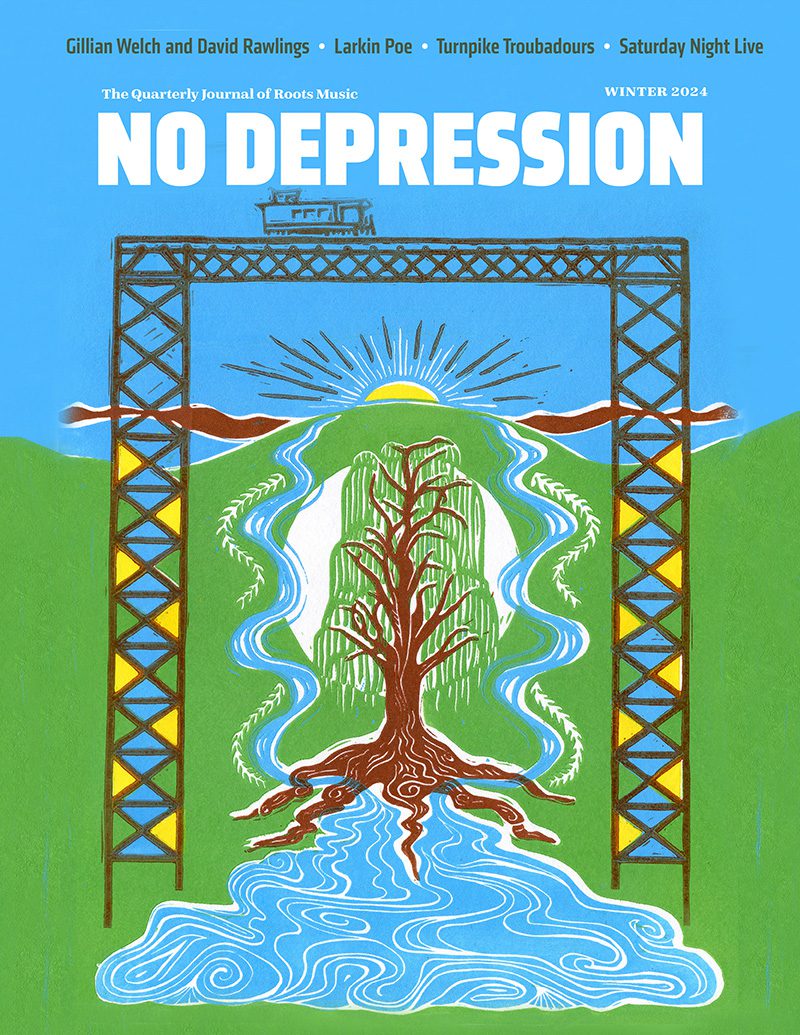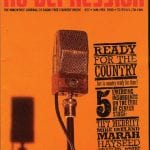James Talley – Estate of the heart
When, for example, Talley sings “This Land Is Your Land”, he betrays none of the exuberance that made the song an anthem on the early ’60s hootenanny circuit. Instead, his ambivalent reading captures the dissonance, the commingled sense of possibility and loss, not only of the original, but of his own life, and that of the Okie line from which he has descended. All of the Guthrie songs Talley sings on the album evince this knowing quality — he doesn’t so much re-create Guthrie’s Oklahoma as he reveals it to be of a piece with his own.
My Daddy Came From Oklahoma
Talley’s early footsteps followed closely in those of America’s greatest folk singer. “My father was born two years before Guthrie, my mother two years after,” says Talley. “They both came from that same Dust Bowl, bound-for-glory period. And I grew up with that — flour sacks stitched together for bedsheets, no running water. When you come out of that, you really understand what Guthrie was all about.”
Talley isn’t just blowing smoke here. Even Guthrie’s daughter Nora was haunted by the kinship between the two men. In a letter to Talley after hearing his new album, she wrote: “[You] sounded eerily like my father! It was hard for me to get passed [sic] that, although I certainly did think [your record] was beautiful.”
Talley’s mother had been a teacher (the one-room schoolhouse where she taught near Stillwater is still standing). When the war effort picked up, she took a job working with her husband at a gunpowder plant in Pryor, Oklahoma. In the mid-1940s, when James was just a few months old, his parents moved from Pryor to Commerce, Oklahoma, just north of Miami, (pronounced “my-a-muh”), the town where Mickey Mantle grew up. “My father used to meet people and say, ‘Shake the hand that shook the hand of Mickey Mantle’s hometown,” Talley chuckles. “My father was proud to be an Okie.” By all accounts, the man also had a sweet tenor voice, played guitar, and doubtless inspired his son to become a musician.
As the Second World War was winding down, Talley’s family moved to Richland, Washington, the town he immortalized in his heart-rending song of the same name on his 1978 Capitol album Ain’t It Somethin’. His father first worked in construction, and then as a chemical operator at the Hanford Works in Richland, a plant located along Guthrie’s beloved Columbia River.
“Hanford was where they made the plutonium for the ‘fat man’ bomb the U.S. dropped over Nagasaki, Japan,” Talley explains. “There are a lot of nuclear waste problems associated with Hanford now. It’s probably where my father ruined his health because when we moved to New Mexico they found a big tumor on one of his lungs that nobody could identify. Back in those days nobody knew too much about uranium and plutonium and what they could do to you.”
The Talleys moved to Albuquerque in 1952, where James’ mom once again taught school and his father did everything from selling appliances door-to-door to delivering milk and working for yet another defense contractor. James Sr. later died there as well, of a heart attack, while his son was studying fine arts at the University of New Mexico.
Contrary to most accounts, Talley never lived in Mehan, Oklahoma, the whistle-stop that provided grist for his still-unsurpassed Got No Bread LP. He did, however, spend childhood summers there, with his maternal grandparents Mary and Og, the couple Talley paints so indelibly in the song “Mehan, Oklahoma”. “Mehan has an awful lot of attachment for me,” he says. “Almost every time I go through Oklahoma I stop there.”
Talley’s grandparents were as poor as the wind-swept dirt they struggled to farm. “There was no running water and you used an outhouse,” he explains. “If you wanted a drink you took it out of the dipper on the back porch. We took baths out in a big galvanized tub in this room out on the back porch.
“There was a little store down on the corner, a funky general store kind of thing. It had one of those coke machines that had everything in a radial arrangement with a little trap door that opened up and you pulled the bottle up out of the ice water. It stood about the same height as this desk [maybe three feet high] and they sat me up on it and had me sing ’em a song. I usually sang ‘Jesus Loves Me’ and they’d give me a nickel or dime to buy a soda pop.
“My grandparents would ride the train into Cushing to go shopping,” Talley continues. “The train had an engine and two cars. My father would get out on the track and flag it down, and it would stop. It would hiss and steam. It made an awful lot of noise for a little kid. It was frightening, that train.”
To Get Back Home
All these things — the hardscrabble living, singing “Jesus Loves Me” for a dime, his parents courting to the music of W. Lee O’Daniel & the Light Crust Doughboys (with Bob Wills on fiddle) at the storied Cain’s Ballroom in Tulsa — made as much of an impression on Talley as the clamorous train to Cushing. Everything about the Dust Bowl and the Okie migration West left its mark on the young Talley, so much so that when he enrolled in graduate school at the University of New Mexico, he concentrated his studies on the art forms of the Depression era. He also sang the songs of Woody Guthrie and began writing originals in the Guthrie mold.
Yet with the Civil Rights Movement in full swing and conflict over the Vietnam War reaching fever pitch, Talley couldn’t content himself with the past. “There was so much turmoil and everything,” he recalls. “Here I am studying the Depression period and reading James Agee and John Steinbeck and listening to Woody Guthrie. All of it had great personal significance for me because of my family. But I couldn’t help but feel there was something more immediate happening. As good as I thought the Guthrie songs I was singing were, I wanted to write songs that were more about current times and my own situation.”
A visit from Pete Seeger proved pivotal for the aspiring singer-songwriter, who had since dropped out of grad school to serve as a welfare caseworker. “One of my English professors from the UNM knew the people who were housing Seeger when he did this concert at the university,” Talley explains. “They told him I’d started writing songs and convinced him to come over and meet with me. He was staying not too far from this little house I was renting [on Montoya Road in the Old Town section of town]. He just walked over to my house, past all the dogs that barked at him and snapped at his heels.
“So I sat down and took out my little Martin guitar and played him two or three songs,” Talley continues. “They were some of my earliest compositions. And he told me, ‘Look, you’ve got some talent, but don’t try to write folk songs like what you’re hearing on those records from New York City. There’s already people doing that. You’re from the Southwest. Look around you. Write about the people around here that you’ve seen. Write about what they’re doing. The rest of it will take care of itself.’ So I kinda began to follow that advice, and out of that grew The Road To Torreon.”




